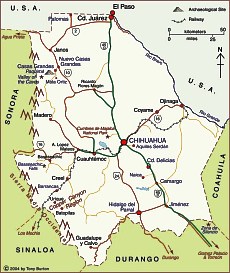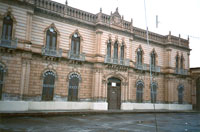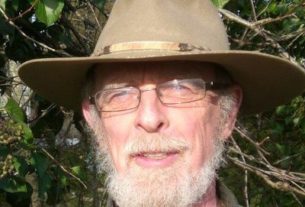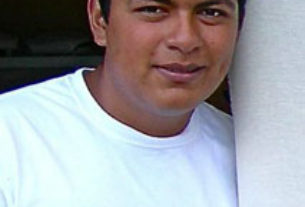Chihuahua, the state capital, is not a particularly tourist-oriented town but it is virtually inevitable that travelers seeking to explore the inner recesses of the state spend a night or two here as part of their itinerary. The city was officially founded at the start of the eighteenth century and its historic buildings stand scattered around the busy downtown area.

Paid for, in part, by a special tax on silver, the richly decorated, eighteenth century, triple-naved stone cathedral exemplifies the baroque, albeit it with numerous later additions and alterations. The cathedral organ was brought from Germany, while the kiosk and sculptures in the adjacent Plaza de Armas (or Plaza de la Constitución) originated in Italy.
Also on the Plaza de Armas is Chihuahua’s city hall. Occupying centre stage in its conference room is this building’s claim to fame: the largest conference table in the world, according to a Ripley’s “Believe or not” column.
Five blocks away, where Juárez meets Calle 5a is the Museo Casa de Juárez. This building functioned as the National Palace for two years during the French Invasion and was Juárez’s official residence during 1864.
Two more blocks brings us to the north side of Plaza Hidalgo, with the state government palace (Capitol) and its murals by Aarón Piña Mora depicting the state’s history. This building, originally the site of a monastery, needed substantial repairs after being damaged by fire in the 1940s. A plaque and the Altar de la Patria in the central patio mark the spot where Father Miguel Hidalgo and his fellow Independence “liberationists” Allende, Aldama and Jiménez, were executed by firing squad in 1811.
 Across the plaza, the Federal Palace (built at the start of this century) incorporates into its structure the much older tower containing the prison cell where Hidalgo was held for 98 days (and, according to the tourist guides, fed on bread and water) prior to his execution. The night before he was executed, Hidalgo, a gentleman to the end, inscribed a poem on his cell wall, thanking his guard and warden for being so kind to him.
Across the plaza, the Federal Palace (built at the start of this century) incorporates into its structure the much older tower containing the prison cell where Hidalgo was held for 98 days (and, according to the tourist guides, fed on bread and water) prior to his execution. The night before he was executed, Hidalgo, a gentleman to the end, inscribed a poem on his cell wall, thanking his guard and warden for being so kind to him.
The Regional Museum (Quinta Gameros) on Calle 4a (4th Street) and Paseo Bolívar, by Parque Lerdo, is one of Mexico’s finest examples of Art-Nouveau. Constructed between 1907-11 on the orders of Manuel Gameros, a mine engineer, it now houses exhibits on archaeology and history.
At Reforma 5 is the Popular Art Museum (Museo de Arte Popular), a modern building with exhibits detailing the life and customs of the Tarahumar Indian people, as well as a small “artesanias” shop selling handmade craft items.
Having “done the downtown”, city tours inevitably conclude by depositing visitors at the doorway to the museum commemorating Pancho Villa. Even if your visit to Chihuahua allows too little time to fully tour the city, at least try to see this building and its contents.
PANCHO VILLA’S MANSION
Strangely, the Museum of the Revolution (Museo de la Revolución) at Calle 10 Norte #3014 is now owned by the Mexican army! Villa’s former 50-room mansion was turned into a museum by his widow, Luz Corral de Villa, who lived here proudly showing it off to visitors until her death in 1981. Many people still refer to it as Quinta Luz or La Casa de Villa. Despite having insufficient signs or information, this museum is, quite rightly, a must-see on most visitors’ agendas. Now standing in silent homage to “El General”, the great man’s personal mementos and furnishings, which once echoed to the sounds of his boisterous gatherings and wild parties, today hover in the background while, drawn by ghoulish magnetism, visitors cluster in the courtyard, counting the holes in his bullet-riddled Dodge roadster.
ROUTES SOUTH
When you’ve had your fill of Chihuahua city, two alternative routes lead to Hidalgo del Parral. These two routes can be combined into a natural circular route, especially for those arriving in Chihuahua from the north.
The faster route uses 38 kilometers of the Cuauhtemoc highway, then branches off south (state highway 25) via Satevó and Valle de Zaragoza. Further east is a less direct and slower route, which affords more sight-seeing possibilities. This second route is along toll-route 45D (with exits to several small towns) south to Jiménez, and then highway 48 west to Hidalgo del Parral.
We’ll travel this latter route. Shortly after leaving Chihuahua, a side road climbs 7 km up into the hills to Aquiles Serdán, a small, neat mining community with a fine eighteenth century church boasting lovely stonework, and a gilded retablo, dedicated to Santa Eulalia de Mérida. Cobblestone and dirt streets separate single-storey pastel houses dotted about the hillside. A newer building houses a small library-cum-museum with a modest display of gemstones and mining memorabilia. The minerals of Santa Eulalia were among the earliest mining discoveries in the region and one mine was already operating as long ago as 1703.
Continuing south, a web of highways and sideroads is centered on the busy agricultural supply centre of Delicias, a largely undistinguished, relatively modern town surrounded by irrigated green fields of corn, grapes, cotton and peanuts. The inhabitants of Delicias celebrate a Grape Fair in early August and a Cotton Fair in late September each year.
South of Delicias, to the west of the highway, is the important mining area of Naica. Here caverns hide selenite crystals. Selenite is a variety of gypsum, the number one ingredient in the bane of students’ lives – blackboard chalk! Here at Naica, crystals grow to more than a meter in length in underground cavities with names like “Cave of the Swords”. Held during meditation, selenite crystals are said to enhance sex drive and fertility and relieve stress.
Back on highway 45D, Ciudad Camargo, an agricultural centre, was named for Ignacio Camargo (1782-1811), another of Mexico’s independence heroes. This town was the birthplace, in 1896, of David Alfaro Siqueiros, Mexico’s famous revolutionary muralist.
Our route diverges from highway 45D at Jiménez, a noisy bustling commercial centre with lots of stores. Perhaps its most interesting building is its turn-of-the-century wrought-iron market structure.
THE CITY OF HIDALGO DEL PARRAL
Founded in 1631, as the Real de San José (Saint Joseph) de Parral, this is one of the most interesting old towns in northern Mexico. Hidalgo del Parral gained its wealth from mines like La Prieta and La Palmilla and the town still houses important historical archives.
The ruins of the fort on Cerro de la Cruz are said to date from the period (1862-7) when French troops occupied the town. At that time, Parral with its picturesque, narrow steep streets and beautifully decorated stone mansions became a truly cosmopolitan city. The town’s somewhat unbalanced coat-of-arms shows a winding river (the Parral) crossed by bridges that look like a cross between real bridges and stylized metal ingots.
WALKING TOUR OF THE CENTER
Let’s walk through central Parral, starting from the main plaza and parish church of San José. In the plaza, the town’s benevolent founder Juan Rangel de Viesma is portrayed, clad in helmet, clutching an ore nugget in one hand, and a mining hammer in the other. Overlooking the plaza is the La Prieta mine.
 A short distance along Avenida Maclovio Herrera is the entrance to the municipal cemetery, complete with Villa’s tomb. Mystery still surrounds the fate of Villa’s mortal remains. While they were supposedly dug up and ceremoniously transported to Mexico City for re-interment alongside others of the nation’s Illustrious Men, local folklore insists that Villa’s remains still lie buried here, the local mayor having previously moved Villas’s bones a few meters from their original site, replacing them with the less illustrious bones of some anonymous commoner. Villa is reported to have said that he would never be left alone even in death and events clearly proved him right.
A short distance along Avenida Maclovio Herrera is the entrance to the municipal cemetery, complete with Villa’s tomb. Mystery still surrounds the fate of Villa’s mortal remains. While they were supposedly dug up and ceremoniously transported to Mexico City for re-interment alongside others of the nation’s Illustrious Men, local folklore insists that Villa’s remains still lie buried here, the local mayor having previously moved Villas’s bones a few meters from their original site, replacing them with the less illustrious bones of some anonymous commoner. Villa is reported to have said that he would never be left alone even in death and events clearly proved him right.
A road up the small hill to the north winds past the modern (1953) Temple of Fátima, before ending at the entrance to the Prieto mine. When mining efforts in the late 1940s finally paid off, the Temple of Fátima was built out of chunks of ore – gold, silver, lead, zinc, antimony, copper, manganese. Instead of pews, the congregation sits on short square pillar stools resembling claim boundary markers. Ore pieces sparkle in the walls and pillars. Sadly, this church is not always left open.
Back in the bottom of the valley and continuing west along the main street, now called Avenida Hidalgo, we pass the lovely two-storey, stone-built Casa Stallforth mansion and Antiguo Hotel Hidalgo. Across the street is the Parral Cathedral, squa shed into a narrow space and correspondingly disproportioned.
shed into a narrow space and correspondingly disproportioned.
Continuing along Hidalgo, to the left, just before the bridge, are two more superb buildings. The two-storey Casa Griesen with its balustrade is closer to Avenida Juarez. Then comes the Palacio Alvarado, constructed between 1899 and 1903. The tortured-looking face over the Palacio’s door is said to represent an Italian miner at work. Alvarado was founder of La Palmilla mine and supposedly became sufficiently wealthy to offer to pay off Mexico’s foreign debt at the start of this century.
Across the bridge, on the right, is the Library and Museo Francisco Villa with photos, newspapers clippings depicting the Revolutionary Hero. Parral was the base from 1910 of much of Villa’s activity and this is the building outside which he was assassinated on July 20, 1923, while on a trip to town from his retirement residence in Canutillo.
VILLA’S HACIENDA
About an hour’s drive south of Parral, highway 45 crosses the stateline into Durango. Just over the border is the ex-hacienda of Canutillo, awarded to Villa (a native of Durango) in 1920 by the government when he retired from fighting. Villa’s former residence houses a small, somewhat unimpressive collection of posters and artwork portraying the early stages of the Mexican Revolution. The collection’s official title, “Museo Grafico de la Revolución Mexicana” or “The Graphical Museum of the Mexican Revolution” is, frankly, more impressive than its content. However, the three kilometer drive in to Canutillo past rural scenes little changed from Villa’s time affords a refreshing change of pace from the speed of the highway. Finding the custodian of the museum (who holds the key to the interior) may take a few minutes but will give you time to look inside the village church with its gilded retablo and capture something of the quintessentially unchanging nature of parts of rural Mexico.
From Canutillo, it is another 360 km to the city of Durango. While fast, this is a route with very few tourist services and you are not advised to set out for Durango unless you are confident of arriving before dark.



